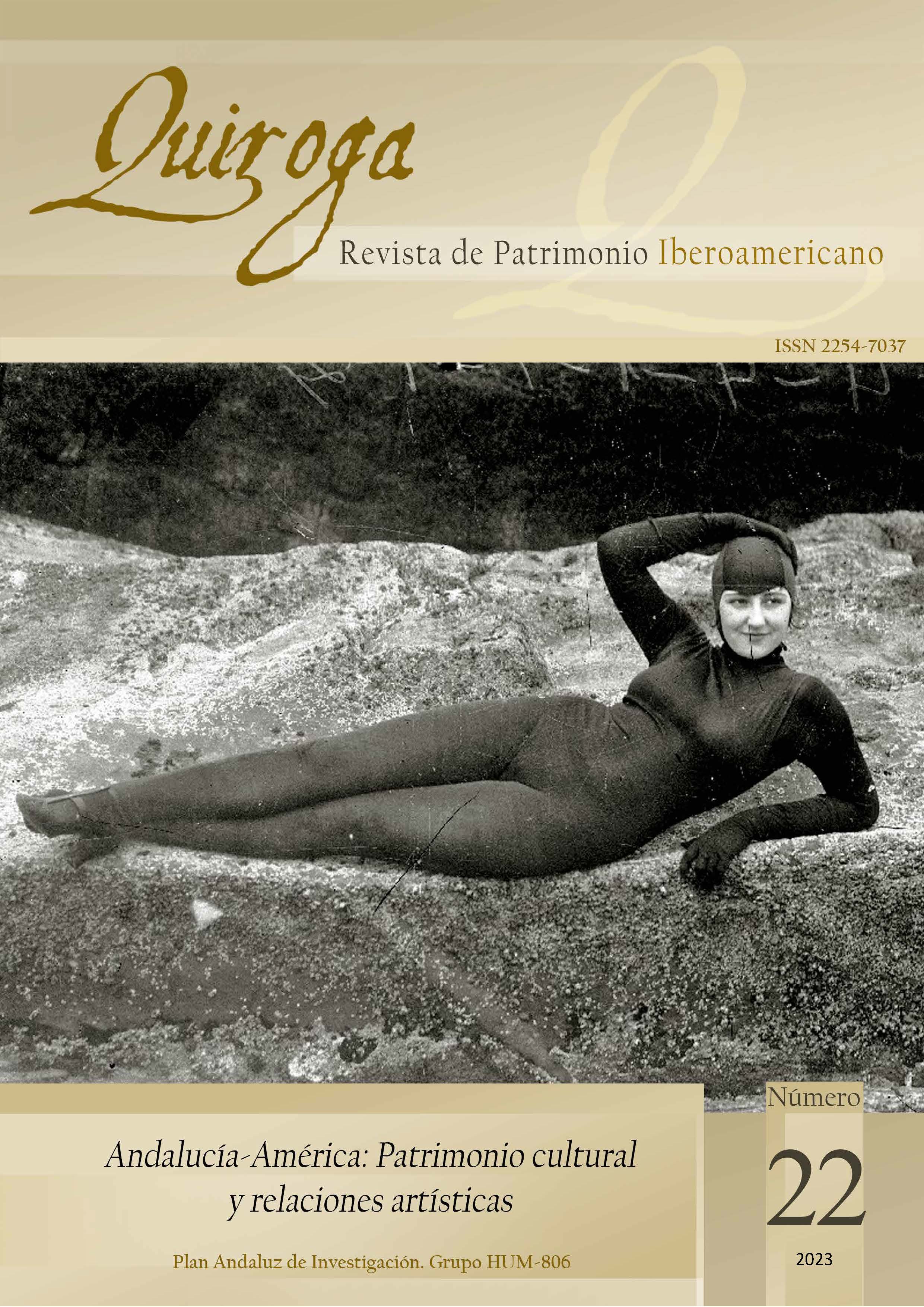The Anthropological Machine: The Automaton in the Early Spanish Cinema
DOI:
https://doi.org/10.30827/quiroga.v0i22.0004Keywords:
Agamben, Automaton, Cinema, Descartes, EarlyAbstract
In this article, we propose a variation of the concept of “anthropological machine” by Giorgio Agamben in which tensions do not occur between humans and animals, but between humans and automatons. To illustrate this, we analyse the representation of automatons in early Spanish cinema: El teatro eléctrico de Bob (Chomón, 1909), Muñecos (Perojo, 1916) and Sanz y el secreto de su arte (Thous and Sanz, 1918). We extend our comment to international productions and subsequent representations.
Downloads
References
AGAMBEN, Giorgio. Lo abierto. El hombre y el animal. Valencia: Pre-Textos, 2010.
ARACIL, Alfredo. Juego y artificio: autómatas y otras aficiones en la cultura del Renacimiento a la Ilustración. Madrid: Cátedra, 1998.
ARENDT, Hannah. La condición humana. Buenos Aires: Paidós, 2003.
ARISTÓTELES. Acerca del alma. Barcelona: Gredos, 2014.
ARISTÓTELES. Política. Madrid: Alianza, 2012.
ARTAUD, Antonin. El cine. Madrid: Alianza, 2018.
BORDWELL, David; STAIGER, Janet y THOMPSON, Kristin. El cine clásico de Hollywood. Estilo cinematográfico y modo de producción hasta 1960. Barcelona: Paidós, 1997.
BURCH, Noël. El tragaluz del infinito. Madrid: Cátedra, 2006.
ČAPEK, Karel. R. U. R. (Rossum’s Universal Robots). Barcelona: Males Herbes, 2017.
CASARES RODICIO, Emilio. Diccionario de cine iberoamericano: España, Portugal y América. Madrid: SGAE, 2010.
CEREZO, Alicia. “Segundo de Chomón y el arte de un cine ‘sin literatura’”. Hispanofilia, vol. 179 (2020), págs. 125-140. DOI: https://doi.org/10.1353/hsf.2017.0013
CORTÉS, Nadia y VALLVERDÚ, Jordi. Corporeidades. México: Secretaría de Cultura / Centro Nacional de las Artes, 2016.
DESCARTES, René. Tratado del Hombre. Madrid: Editora Nacional, 1980.
DESCARTES, René. Meditaciones metafísicas. Madrid: Alianza, 2005.
DESCARTES, René. Discurso del método. Madrid: Alianza, 2011.
EPSTEIN, Jean. La inteligencia de una máquina. Una filosofía del cine. Buenos Aires: Cactus, 2015.
FREUD, Sigmund. “Lo ominoso”. Obras completas, vol. XVII (1917-1919). Buenos Aires: Amorrortu, 1986.
GÓMEZ, Ivan. “Cine 1900-1980”. En: LÓPEZ-PELLISA, Teresa (ed.). Historia de la ciencia-ficción en la cultura española. Madrid: Iberoamericana Vervuert, 2018. DOI: https://doi.org/10.31819/9783954877102-010
GÓMEZ DE LA SERNA, Ramón. Ismos. Madrid: Guadarrama, 1975.
GUBERN, Román. Benito Perojo, pionerismo y supervivencia. Madrid: Filmoteca Española, 1994.
GUNNING, Tom. “The Cinema of Attraction(s): Early Film, Its Spectator and the Avant-Garde”. En: WANDA, Strauven (ed.). The Cinema of Attractions Reloaded. Ámsterdam: Amsterdam University Press, págs. 381-388.
HIGUERAS FLORES, Rubén. Cine fantástico y de terror español. De los orígenes a la Edad de Oro (1912-1983). T&B, 2014.
HOFFMANN, Ernest Theodor Amadeus. Cuentos, I. Madrid: Alianza, 2002.
ISHIGURO, Hiroshi. “Android science”. En: KASAKI, Masashi, ISHIGURO, Hiroshi, OSAKA, Mariko y FUJIKADO, Takashi (eds.). Cognitive Neuroscience Robotics A: Synthetic Approaches to Human Understanding. Nueva York: Springer, 2016.
IZQUIERDO ANRUBIA, José. Francisco Sanz Baldoví. El prodigioso caballero de la fantasía. Anna, 2014.
KANG, Minsoo. “The Mechanical Daughter of Rene Descartes: The Origin and hHistory of an Intellectual Fable”. Modern Intellectual History (Cambridge), 14 (3) (2017). DOI: https://doi.org/10.1017/S147924431600024X
KRACAUER Siegfried. De Caligari a Hitler. Historia psicológica del cine alemán. Barcelona: Paidós, 1985.
LA METTRIE, Julien Offray de. El hombre máquina. Madrid: Alhambra, 1987.
MAKELA, Lee (2014). “From Metropolis to Metoroporisu: the changing role of the robot in Japanese and Western cinema. En: MACWILLIAMS, Marc W. Japanese Visual Culture. Explorations in the World of Manga and Anime. Londres: Routledge, págs. 91-113.
MINGUET BATLLORI, Joan M. “Segundo de Chomón y el cine de los orígenes. Apuntes para una revisión”. Secuencias: revista de historia del cine, nº 27.(2007), págs. 53-65.
MINGUET BATLLORI, Joan M. “Segundo de Chomón and the Fascination for Colour”. Film History, vol. 21, nº 1, Early Colour Part I (2009), págs. 94-103. DOI: https://doi.org/10.2979/FIL.2009.21.1.94
MUSSER, Charles. Before the Nickelodeon: Edwin S. Porter and the Edison Manufacturing Company. Los Ángeles: University of California Press, 1991. DOI: https://doi.org/10.1525/9780520323728
PEDRAZA, Pilar. Máquinas de Amar. Secretos del Cuerpo Artificial. Madrid: Valdemar, 1998.
REILLY, Kara. Automata and Mimesis on the Stage of Theatre History. Nueva York: Springer, 2011. DOI: https://doi.org/10.1057/9780230347540
SÁNCHEZ-BIOSCA, Vicente. El montaje cinematográfico. Teoría y análisis. Barcelona: Paidós, 1991.
SCHWARTZ, Louis-Georges. Mechanical Witness: A History of Motion Picture Evidence in US Courts. Oxford: Oxford University Press, 2009. DOI: https://doi.org/10.1093/acprof:oso/9780195315059.001.0001
SUVIN, Darko. Metamorphoses of Science Fiction: On the Poetics and History of a Literary. Berna: Peter Lang, 2016. DOI: https://doi.org/10.3726/978-3-0353-0735-1
TODOROV, Tzvetan. Introducción a la literatura fantástica. México: Coyoacán, 2016.
TRÍAS, Eugenio. Lo bello y lo siniestro. Barcelona: Random House Mondadori, 2006.
VALLVERDÚ, Jordi. “The Situated Nature of Informational Ontologies”. En: DODIG-CRNKOVIC, Gordana y BURGIN, Mark (eds.), Philosophy and Methodology of Information, World Scientific, 2019. DOI: https://doi.org/10.1142/9789813277526_0016
VALLVERDÚ, Jordi. “The Eastern Construction of the Artificial Mind”. Enrahonar : Quaderns de Filosofia, 47, 2011. DOI: https://doi.org/10.5565/rev/enrahonar/v47n0.170
VALLVERDÚ, Jordi y MÜLLER, Vincent C. Blended Cognition: The Robotic Challenge. Springer, 2019. DOI: https://doi.org/10.1007/978-3-030-03104-6
VALLVERDÚ, Jordi y TALANOV, Max. “Naturalizing consciousness emergence for AI implementation purposes: A guide to multilayered management systems”. En: VV.AA. Advanced Research on Biologically Inspired Cognitive Architectures, 2017. DOI: https://doi.org/10.4018/978-1-5225-1947-8.ch002
Downloads
Published
How to Cite
Issue
Section
License
(c) Quiroga. Los originales publicados en la edición electrónica de esta Revista son propiedad de la misma, siendo necesario citar la procedencia en cualquier reproducción parcial o total.
Salvo indicación contraria, todos los contenidos de la edición electrónica se distribuyen bajo una licencia de uso y distribución "CREATIVE COMMONS RECONOCIMIENTO-NO COMERCIAL 4.0 ESPAÑA" (CC-by-nc). Puede consultar desde aquí la versión informativa y el texto legal de la licencia. Esta circunstancia ha de hacerse constar expresamente de esta forma cuando sea necesario.













